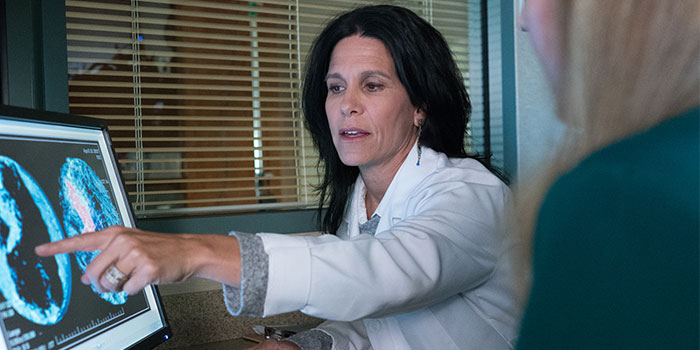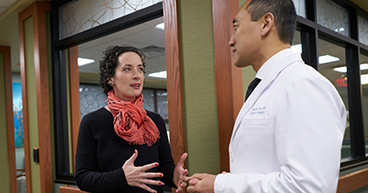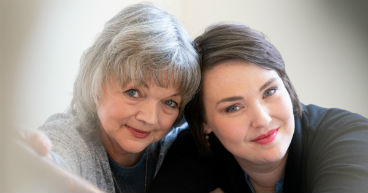
It may surprise you that I had both my breasts surgically removed this year even though I don't have breast cancer. I also don’t have a BRCA gene mutation that puts women at high risk for developing breast cancer—like the one that led actress Angelina Jolie to have a double mastectomy in 2013.
In fact, I don’t have the usual risks that indicate a likelihood of breast cancer. I do pretty much all the things we doctors recommend to help people avoid getting cancer: I don’t smoke, I eat healthfully and maintain a good body weight, I limit how much alcohol I drink, I exercise regularly, and I wear sunscreen outdoors.
So, the surgery I had may seem like a crazy, crazy decision to some women. How could I take off a body part (actually two) without having cancer? The answer is simpler than it appears: The lack of a breast cancer gene mutation and all the prevention steps I was taking weren’t enough to stop me from being at high risk for breast cancer.
First, there was my family history. My grandmother died from an unknown female cancer when I was young. My aunt, my mother’s older sister, was diagnosed with breast cancer in her 40s and died from it in her 50s. My older sister was diagnosed with breast cancer in 2019.
After my sister’s diagnosis, I met with a genetic counselor, and together we did a comprehensive risk assessment. There were several other parts of my life, along with my obvious family history, that put me at an unacceptable (for me) high risk of developing breast cancer. Even as a doctor who mainly treats breast cancer, I had not thought of these items as contributing factors.
The bottom line is it’s very important to know your own risk for breast cancer. It is not as simple as are you a gene carrier or not. Breast cancer risk is much more comprehensive. It is also essential to know your treatment options based on your own personal risk. Options for women at high risk may range from undergoing additional and more detailed screenings, to taking a pill or a medicine to reduce risk, to, in my case, risk-reduction surgery.
As a Radiation Oncologist and Chief of Staff at Cancer Treatment Centers of America® (CTCA), Phoenix, I see firsthand how important this information is for women. I’m therefore writing this guide to explain what you should know about breast cancer and which options are available to reduce your risk of being diagnosed with it. These are a few topics:
- Risk factors and prevention
- Breast cancer screening
- Breast cancer symptoms
- Genetic counseling or testing
- What to do if you’re at high risk
- The CTCA experience
As you read on, you’ll come to understand as I do that breast cancer risk is not black and white. It’s not gene or no gene. There’s a spectrum. Decades from now, we may look back and say, “Wow, we didn’t know about all these other BRCA genes back then, but we do now.”
If you're interested in scheduling a cancer screening at CTCA®, or if you believe you have symptoms of cancer and want to schedule an appointment for a diagnostic evaluation, call us or chat online with a member of our team.
Risk factors and prevention
Most cancers have two categories of risk factors: those you can control and those you can’t. Prevention strategies are designed mainly to reduce risks from the factors you can control. With breast cancer, these risk factors and possible prevention steps) include:
- Smoking: Quit smoking and don’t use other tobacco products.
- Excessive alcohol consumption: Limit yourself to moderate drinking, which is defined as one drink—12 oz. of beer, 5 oz. of wine or 1.5 oz. of distilled spirits—per day.
- Obesity: Lose weight through dieting and healthy eating habits.
- Sedentary lifestyle: (Exercise regularly, meaning at least 2.5 to 5 hours per week of moderate exercise such as walking, or 1.25 to 2.5 hours per week of more intense exercise, such as running.
These recommendations are not about eliminating risk. They’re about risk reduction.
Many risk factors you can’t control, including the following and their associated risks:
- Gender: While some men develop breast cancer, the vast majority of cases are in women.
- Age: Most breast cancers are found in women over age 55.
- Family history: Your breast cancer risks double if your mother, daughter or sister has it.
- Genetics: Individuals who have a mutation of the BRCA1 or BRCA2 genes are at greater risk.
- Reproductive history: Women who haven’t had children, or who had their first child after age 30, are at increased risk of breast cancer. Risks also increase for women who began menstruating before age 12 or started menopause after age 55.
- Hormone intake: Hormone-related birth control or menopausal drugs, such as combined hormone therapy taken after menopause, may elevate risk.
- Race: White women are more likely to develop breast cancer than black women, but black women are at greatest risk for cancer before age 40. Women of Ashkenazi Jewish ancestry are also at greater risk.
- Dense breasts: The more glandular and fibrous tissue in your breasts and the less fatty tissue, the greater your risk.
Screening for breast cancer

The most common screening for breast cancer is the mammogram, which involves taking pictures of your breasts using special X-ray machines. There are different recommendations for when you should start having mammograms and how often they should be done. The American College of Radiology and the Society of Breast Imaging recommend women who are not considered at high risk for developing breast cancer begin yearly screenings at age 40.
If you are at high risk, maybe because you have a family history of breast cancer like me or you carry a genetic mutation known to be linked to breast cancer, you should start your exams at an earlier age. Talk to your doctor about when that should be. In some cases, the determination may be based on the age at which one of your close blood relatives developed breast cancer.
How do you find out more about your risk? The American Society of Breast Surgeons recommends undergoing a formal risk assessment for breast cancer as early as age 25.
Screening is all about early detection. A mammogram may detect a cancer that wasn’t noticeable to the touch. We know that cancers that are caught early are more easily treated and have better outcomes. That’s why regular screening is important—and not just for breast cancer. Cancer screenings include having regular Pap smears to check for cervical cancer and colonoscopies for colorectal cancer.
My advice to my patients and their families—and to my own friends and family—is to develop a relationship with your primary care physician and make sure you get the screening that’s right for your age and gender.
You should also be vigilant between screenings. If you detect a lump in your breast, even if you just recently had a mammogram, contact your doctor and have it checked out. My sister had her regular screening mammogram and months later actually felt a lump in one of her breasts. That’s what ultimately led her to a biopsy and a diagnosis of breast cancer. Not every breast lump is cancerous, but every lump should be investigated by a physician.
Breast cancer symptoms
A lump in your breast is not the only potential symptom of breast cancer. Some other indicators that may be warning signs of breast cancer include:
- Swelling in the breast, with or without a noticeable lump
- General pain in or on a breast, including irritations or itchiness
- A change in the appearance of a nipple, or a nipple discharge that’s not breast milk
- A change in the appearance of a breast (size or shape), or a redness that develops in the breast
- Peeling or flaking of nipple skin
- Inverted nipples (turned inward)
It’s very easy to dismiss a sign or symptom, especially because we’re so busy, but that’s a mistake.
Genetic counseling and genetic testing
As I watched my sister go through cancer treatment, I realized I needed to evaluate my own risk, even though both my mother and sister had tested negative for a BRCA mutation. CTCA had launched an online risk assessment tool. It was brand new at the time, and I just entered in my information. When it came back showing I was at high risk, a colleague suggested I meet with a genetic counselor.
Consulting a genetic counselor doesn’t equal genetic testing. It means understanding risk and filling out form after form about risk factors. The forms largely cover lifestyle and family information. The counselor may recommend genetic testing to see whether you have a mutated BRCA gene, which didn’t turn out to be the case for me.
As I was filling out these forms, I felt confident that my lifestyle factors were going to put me in a low-risk category. I was very surprised to see my number in bold red—very high risk.
What to do if you’re at high risk
In consultation with my doctors, I decided that surgically removing my breasts, which is also called a double or bilateral mastectomy, was the right option for me. I’m not advocating it for every woman at high risk of breast cancer. It’s so important to go over your particular situation with your doctor—to make sure your decision is appropriate for you and that it’s something you’re comfortable with.
The plan may involve nothing more than having more frequent mammograms or starting them at an earlier age. It may involve having more comprehensive mammograms or additional testing such as an MRI.
In some cases, your doctor may want to prescribe drugs, primarily to reduce the level of estrogen that may increase your risk of cancer. These medications include tamoxifen or an aromatase inhibitor such as anastrozole. The drug raloxifene has been shown to reduce breast cancer risk in post-menopausal women.
A bilateral mastectomy may be an option for some women who are at greatest risk. In such cases, surgery may include not only a bilateral mastectomy but removal of the ovaries as well. Women considering a mastectomy should also consider the possibility of breast reconstruction surgery and thinking through ahead of time how they feel about that option.
The CTCA experience
Our core mission at CTCA includes making screening and diagnostic tools available to as many patients as possible. That’s why we’ve developed our Cancer Screening and Diagnostic Program at each of our hospitals for patients at high risk for cancer and those who fit recognized breast cancer screening guidelines.
We also have a robust genetic counseling and genetic testing program, which is why I chose to meet with a genetic counselor here at our Phoenix hospital. He helped me determine which genetic tests I should have, and helped me understand my results.
Because we treat only cancer at CTCA, we’re able to help patients understand their options should screening results indicate the need for a follow-up visit. Our board-certified oncologists and other clinicians are trained to determine whether cancer has developed and, if so, to offer treatment options tailored to you and your individual needs and diagnosis.
In fact, many patients come to CTCA for breast cancer treatment because of our expert, personalized model of cancer care, which uses an integrative, patient-centered approach. At our three Breast Cancer Centers, we only treat breast cancer, which means we have expertise with the broad spectrum of diseases involved, including triple-negative breast cancer and inflammatory breast cancer. I was able to experience that specialization firsthand as a CTCA Breast Cancer Center patient—even though I didn’t have breast cancer, I was treated by a breast surgeon, who performed my double mastectomy, and by a reconstructive surgeon, who performed reconstructive surgery to give me new breasts.
Having a double mastectomy was a significant cancer prevention effort for me, but it doesn’t guarantee I won’t get breast cancer. It’s just not possible at this point for surgeons to know they haven’t left behind a small amount of breast tissue that could become cancerous. Still, it was the right decision for me.
Knowing your history and knowing your own story is your most powerful tool. Make sure your doctor or health care provider understands your story—your risks and your family history—and seek out a genetic counselor to help you assess your risks if concerns arise.
If you're interested in scheduling a cancer screening at CTCA, or if you believe you have symptoms of cancer and want to schedule an appointment for a diagnostic evaluation, call us or chat online with a member of our team.



